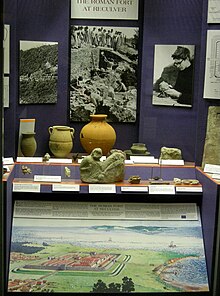Regulbium
| Regulbium | |
|---|---|
 Remains of the perimeter wall of Regulbium Roman Fort | |
Location in Kent | |
| Location | |
| Coordinates | 51°22′44″N 1°12′00″E / 51.379°N 1.200°E |
| Town | Reculver |
| County | Kent |
| Country | England |
| Reference | |
| UK-OSNG reference | TR228693 |
Regulbium was the name of an ancient Roman fort of the Saxon Shore in the vicinity of the modern English resort of Reculver in Kent. Its name derives from the local Brythonic language, meaning "great headland" (*Rogulbion).
History
The first Roman military installation in the area was a small fort built directly after the
The masonry castrum at Reculver is unusually early for its location and type,[2] but it can be compared in both age and design with the forts at Brancaster and Caister-on-Sea, both in Norfolk,[3] and it may be that "the east coast was in need of protection before the south coast, which was patrolled by the Roman navy, the Classis Britannica."[4] The design of the fort at Reculver can also be compared with those along Hadrian's Wall, in northern England.[5] The Notitia Dignitatum (whose western records date from the early 5th century but probably describe the situation at a slightly earlier date), reports the garrison at Reculver as the Cohors I Baetasiorum, and this is reflected in the discovery there of tiles stamped with the initials "CIB".[6] The Cohors I Baetasiorum were previously stationed at Maryport, in Cumbria, and, since they probably built the fort at Reculver, this may explain the similarity between it and the forts along Hadrian's Wall.[6]
After the arrival of the

Location and construction
The fort stood on the mainland side of the northern entrance to the mile-wide Wantsum Channel, which separated the Isle of Thanet from the mainland. The Channel was a favoured passage for shipping, and the fort was built to both control it and act as a navigational marker. The construction was typical of a Saxon Shore fort, square-shaped with rounded corners. The single rampart was 10 feet (3.0 m) thick at the base tapering to 8 feet (2.4 m) at the top, with a height of probably 20 feet (6.1 m). It was additionally strengthened by an earthen rampart on the interior, and surrounded by two external ditches. The fort covered an area of 3.06 ha, but almost half of that has been lost to the sea due to erosion.
References
- ^ Philp, Brian (1969). "The Reculver Inscription". Kent Archaeological Review (17).
- ^ Allen, J.R.L. & Fulford, M.G. (1999), "Fort Building and Military Supply along Britain's Eastern Channel and North Sea Coasts: The Later Second and Third Centuries", Britannia 30, pp. 163–4.
- ^ Philp 2005, pp. 225–6; Harris 2001, pp. 32–3
- ^ Harris 2001, p. 33.
- ^ Harris 2001, p. 32.
- ^ a b Philp 2005, pp. 224–5.
- ^ Garmonsway, G.N., The Anglo-Saxon Chronicle, Dent, Dutton, 1972 & 1975, pp. 34-5.
Sources
- Fields, N. (2006), Rome's Saxon Shore - Coastal Defences of Roman Britain AD 250-500 (Fortress 56), ISBN 978-1-84603-094-9
- Harris, S. (2001), Richborough and Reculver, London: English Heritage, ISBN 978-1-85074-765-9
- Johnston, D.E.; et al. (1977), "The Saxon Shore" (PDF), CBA Research Report (18), retrieved 20 August 2007
- Philp, B. (1969), "The Roman Fort at Reculver Excavations 1968 – Interim Report.", Kent Archaeological Review (15), retrieved 10 August 2008
- Philp, B. (2005), Report on the Excavations of Roman Reculver, Kent Archaeological Rescue Unit, ISBN 0-947831-24-X

